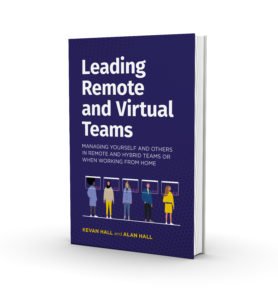Too many meeting requests when working from home?
Many people working from home have experienced a sharp increase in the number of virtual meetings they have been invited to. This might be a short term overreaction to the lack of other forms of communication and social contact but it is starting to get in the way of people’s ability to be effective. This video gives some practical tips on how to deal with this based on our book Kill Bad Meetings.
The video is free for you to use to help your people manage the transition during the CORVID 19 crisis. You can see the rest of the videos in this series here
You can see more about what we’re doing to support organizations and individuals during this period here
Transcript
Hi my name is Kevan Hall and I’m the CEO of Global Integration. I’ve worked from home for over 30 years and trained over 100,000 people in the skills of working remotely
In the last couple of weeks, we have run webinars for thousands of people new to working from home and people are starting to experience some of the classic challenges that this brings
In this initial stage we have called this NORM as it’s likely to be our normal way of working for some time.
A lot of our work so far has been in the N – providing tips, tools and reassurance for people who are either new to working from home or who have worked occasionally from home but are now finding that working five days a week this way is quite different.
Once they have got set up a lot of people are telling us they are now experiencing a large increase in the number of virtual meetings they are asked to attend.
We are also training large groups of people to run much more interactive online meetings as they often lack participation, but the issue I want to talk about today is how to deal with the sheer volume of meeting requests we are receiving.
I’m experiencing it myself with 4:30 a.m starts for webinars with Asian clients, internal and external meetings through WebEx, MS teams and Zoom and 1-2-1 calls with colleagues in the US in the evening. On top of that I have more social calls with colleagues, family and friends – all through virtual meetings.
Some meetings of course are essential, in this session I will show you how to push back against the ones that aren’t and cut out unnecessary topic and meetings. The ideas come from our book Kill Bad Meetings and we know this can save you up to a day a week of unnecessary work.
Part of the increase in the number of meetings is the desire to connect both for business reasons and in a genuine attempt to provide social contact and overcome the potential isolation of working at home. Whilst its admirable that people are trying so hard it sounds like some are going too far. Sitting in a boring and irrelevant meeting on mute does not really help build community and overcome social isolation. There are better ways.
I suspect this initial boost of meetings will start to settle down over time where we find the right balance between connectedness and getting things done.
Meetings are a problem with the best of times, in our research for the book my colleague Alan and I observed many meetings and surveyed thousands of people, they told us they spent on average two days per week in meetings and about 50% of the time the content was irrelevant and they didn’t need to be there.
My sense is that the number of meetings has increased since people have been working at home.
Here are some of our tips on dealing with this increase
Say no to more meetings
First, recognize which meetings are good use of your time, and which are not.
Good meetings are ones where you need to share expertise and the topics really require synchronous collaboration, that is where people need to be live in the same time if not the same place. It’s also important if you’re dealing with issues around conflict or where you need to build relationships
On the other hand, if there’s no clear outcome, the topics are not relevant, you’ve got no real role except to listen, or the outcome could be delivered without a meeting, then you may want to push back at the meeting invitation.
If you just automatically accept meeting invitations, particularly those without an agenda, you’re basically saying that anything the other person wants to talk about is a better use of your time than anything you could think of.
It can be challenging to say no to meeting Invitations, particularly to your boss, So we need some strategies for dealing with this
Our suggestion is that you just ask some simple questions, What is the agenda? What does the meeting organiser need from you specifically at the meeting so you can prepare? Is there another way you could meet their needs rather than attending the meeting?
Alternatively, you can make the implications of attending more explicit – what will you need to
de-prioritize in order to attend?
We found that almost any barrier, challenge or question you put in the way of automatic acceptance will at least drive a conversation about whether you need to attend . Sometimes it’s as simple as that.
Identify the topics that don’t need a meeting
Our next tip is that not everything needs a meeting or collective work. A simple way to identify this used to use this meeting’s check sheet.
For your next meeting, write the topics down the left hand side and the names of the attendees along the top. Then, when anyone speaks, simply make a check mark in the relevant box. At the end of the meeting you will have a visual record of what topics people participated in. Now we know that how often people talk isn’t the only measure of contribution, but it does give you a simple measure to drive a conversation on how to improve your meetings.
At the end of the meeting you will have a check sheet that looks something like this. The next step is to categorise the types of topics that you found. Based on observing many meetings we found that these patterns occur regularly.
- Topics 1 and 5 really only have one to one interest
Topic 2 It’s probably a broadcast of information with one person presenting and others only talking to share information that’s relevant to them and the topic leader – Status updates often follow this pattern
Topic 3 is really interesting, but only to half the people
Topics 4 and 6 are relevant to everyone
This table then gives you some ideas on how you can deal with these issues. In summary only the topics where everyone is engaged really require a full meeting, the 1 to 1 and broadcast topics rarely require a live collective meeting, they can usually be handled through other technologies such as sending an email , video or shared document.
Save a day a week
Typically, we find that about 40% of meeting content is the things that don’t really require meeting.
This can be a challenge to existing meeting agendas and ways of working so you might want to discuss doing this with your meeting leader. Use the information to drive a discussion in your team about what topics you need to discuss, and what you don’t
In a remote environment virtual meetings and audio conferences are the only place where real collective collaboration happens. As a result your meetings culture is your collaboration culture during this period.
Take this opportunity to improve your meetings, save yourself time and improve your collaboration. We have found these practical tips can save you up to a day a week so it’s worth putting in some effort and stimulating discussions around these ideas in your meetings. There are lots more tips in our book.
Use the time to really connect
By all means use some of the time you save for more social communications, they are essential at this time, one to one or small group virtual coffees with no formal business agenda are great. When you are socializing you don’t tend to do it with 20 people at once. In a virtual environment 4-6 may be the most you can have a meaningful conversation with – and it is conversation people want, not listening to broadcast.
I wish you good luck in reducing the number and improving the quality of your online meetings. Find out more about how we can help here
See an interactive graphic of our working from home learning path and training module contents. Download our latest white paper on working from home.
Read our book – Leading remote and virtual teams: Managing yourself and others in remote and hybrid teams or when working from home.


Explore our training programs to see how we can help.
Agile & Digital Training Matrix Management Training People and purpose Training Virtual Teams TrainingEducate yourself further with a few more or our online insights:
30 years of experience learning with a range of world class clients
We work with a wide range of clients from global multinationals to recent start-ups. Our audiences span all levels, from CEOs to operational teams around the world. Our tools and programs have been developed for diverse and demanding audiences.

Tailored training or off the shelf modules for your people development needs
We are deep content experts in remote, virtual and hybrid working, matrix management and agile & digital leadership. We are highly flexible in how we deliver our content and ideas. We can tailor content closely to your specific needs or deliver off the shelf bite sized modules based on our existing IP and 30 years of training experience.
For more about how we deliver our keynotes, workshops, live web seminars and online learning.